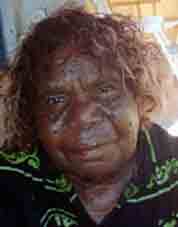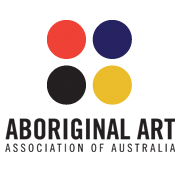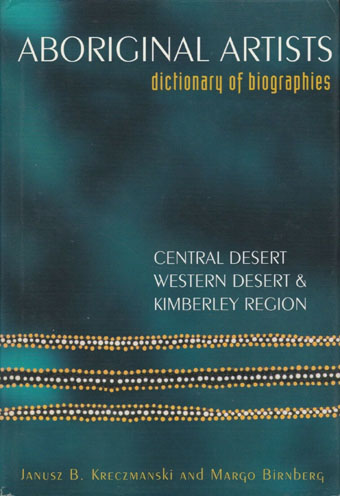|
Wentja
2
Napaltjarri Biography:
Biography
Encyclopedia of
Aboriginal Artists
Dictionary of Biographies,
page 221.
 Wentja
Morgan
Napaltjarri
is an artist and a custodian of law.
Wentja
began painting for Papunya Tula. Wentja
Morgan
Napaltjarri
is an artist and a custodian of law.
Wentja
began painting for Papunya Tula.
Wentja paintings key motif is the
Rockhole which represent mesmerizing connecting circles in the Desert. She
paints with emotional dynamism the place where her family sang and camped.
Wentja songs and music are fused into her paintings. Her paintings
Wentja work has been exhibited in leading Australian and international
exhibitions, including the 2003 exhibition Masterpieces from the Western
Desert, held in London. Her works are included in major collections,
such as the Kerry Stokes and Thomas Vroom Collections and the National
Aboriginal Art and Culture Institute in Adelaide.
Apart from the place of birth, the other crucial factor in
Wentja Morgan
Napaltjarri
formation as an artist was her parentage.
Wentja Morgan
Napaltjarri
father was
Shorty Lungkata Tjungurrayi
(1920-1987), a Pintupi man who was one of the outstanding founding
figures in the Papunya painting movement, while her mother was Napulu
Nangala.
Wentyja
father
Shorty Lungkata Tjungurrayi
was
one of the original founders of the Western Desert art movement.
Wentjae was entrusted with many of her father’s Tjukurrpa and the
animals that appear within them, including bandicoots, echidnas and goannas.
In many
of her paintings Wentja Morgan Napaltjarri employs the roundel or oval
shape—also encountered in the work of her father—to depict the rockhole.
Frequently, a series of roundels represents several rockholes, and the mandala-like
shapes so formed function as a powerful meditative locus. The genius of Wentja
Morgan Napaltjarri thus is encapsulated in her conveying of an authentic sacred
narrative within a fully realised art object of considerable hypnotic power.
Wentja Morgan Napaltjarri
was born in 1945 in Pintupi country North-West of Walungurru, she came first
to Haasts Bluff then moved to Papunya.
Wentja's husband was
Ginger Tjakamarra (1940-2008),
they met
at Haasts Bluff and the
couple eventually moved to Papunya, where Wentja started painting with
Shorty Lungkata Tjungurrayi (her
father).
Wentja Morgan Napaltjarri
(and her sister, Tjunkiya Napaltjarri)
took part in the Minyma Tjukurrpa
Project (Women’s Dreaming Project) from the Ikuntji (Haasts Bluff) and
Walungurru (Kintore) Art Centres.
Wentja
work was included in the first exhibition of paintings produced at that time.
Wentja Napaltjarri has now been painting all of her life. Her first works
were collaborative, helping out the men in the family with their work. While
they painted the stories, Wentja did the dotting in-fill, characteristic of the
Papunya Tula artists to whom her father belonged.
Wentja lives at Mt Liebig
and continues
her career painting for Watiyawanu Artists.
Wentja mostly
paints Blue Tongue Lizard and Water Dreaming stories, the
iconography for which has been handed down to her by her father. She
also paints Sandhills, Rockholes, and other landmarks associated
with Water and Desert Oaks.
In contrast to her father's work, Wentja's paintings are less geometric with a
softening of iconography through interlacing with intricate finely dotted
patterning. This soft dotting technique is characteristic of many of the Mount
Liebig women artists with whom she paints.
Wentja Morgan
Napaltjarri distinctive style
paintings are
highly sought by the Australian and
international art collectors.
Wentja 2
creates
top-quality
modern paintings and some have
powerful multi-dimensional nature and the sheer physical presence of
much contemporary work of art that neither can be replicated by digital
image as the intricate details and subtle shades of colour wash are lost in the
process of internet transfer.
Wentja's early system of connecting concentric circles and dotted bands has been
replaced by mesmerising fields of tonal colours. Her paintings display a key
motif, in most cases a large roundel, which represents an important rockhole
where her family regularly camped. Surrounding the rockhole is a charged energy
field of intricate dots. While she works, Wentja sings about the rockhole, and
the songs and music are incorporated into her paintings.

Aboriginal Artists
Dictionary of Biographies
is
meticulously researched biographical dictionary
446 pages
hardcover
book, containing more than
1000 entries and
(colour illustrations). The book includes a brief biography and relevant
exhibition entries for artists who painted from the beginning of the
1970’s to the first decade of the 21st century. The definitive work on
the subject of desert artists.
AWARDS
2008 finalist 25th National Aboriginal and Torres Strait Islander Art
Award
2007 finalist 24th National Aboriginal and Torres Strait Islander Art
Award
2006 finalist 23rd National Aboriginal and Torres Strait Islander Art
Award
2006
34th Alice Prize, National Contemporary Art Award, Araluen
Arts Centre, Alice Springs, NT
2005 22nd National Aboriginal and Torres Strait Islander Art
Award
2004 21st Telstra National Aboriginal and Torres Strait Islander Art
Award,
2004
Runner Up, Advocate Art Award, Araluen Arts Centre, Alice
Springs, NT 33rd Alice Prize, National Contemporary Art Award, Araluen
Arts Centre, Alice Springs, NT
2003 20th Telstra National Aboriginal and Torres Strait Islander Art
Award, MAGNT
2002 19th Telstra National Aboriginal and Torres Strait Islander Art
Award, MAGNT
2001 18th Telstra National Aboriginal and Torres Strait Islander Art
Award, MAGNT
COLLECTIONS
Amsterdam The Netherlands Art Gallery of South Australia, Adelaide
Tandanya National Aboriginal Art and Cultural Institute Inc. Adelaide
Flinders University Museum, Adelaide Kerry Stokes Collection, Perth Art
Gallery of Western Australia, Perth Queensland Art Gallery, Brisbane The
Kaplan – Levi Collection, Seattle
Art Bank Sydney
Art Gallery of South Australia
( Rockholes
west of Kintore 2007)
Homes a Court Collection, Perth
Art Gallery of Western Australia
Queensland Art Gallery
Museum and Art Gallery of the Northern
Territory
The Kerry Stokes Collection,
Australia
National Aboriginal Art and Cultural Institute Tandanya
Flinders University Museum
Thomas Vroom Collection
Tandanya National Aboriginal Art & Cultural Institute
private and corporate collections in
Denmark, Poland, England and
Germany
Selected
Exhibitions
Wentja work has been exhibited in leading Australian and
international exhibitions, including the 2003 exhibition
Masterpieces from the Western Desert, held in London. Her works are
included in major collections, such as the Kerry Stokes and Thomas
Vroom Collections and the National Aboriginal Art and Culture
Institute in Adelaide.
Solo Exhibitions
2014 ‘Malparinga: My father’s home’, Art Equity, Sydney, NSW
2010 ‘Rockholes West of Kintore’, Wentja Napaltjarri, Art Equity,
Sydney, NSW
2009 ‘Wentja Napaltjarri’, Peta Appleyard Gallery, Alice Springs, NT
2008 ‘Masterpieces from the Western Desert: Bill Whiskey Tjapaltjarri &
Wentja Morgan Napaltjarri’, Peta O’Brien Contemporary Art, COSA, London,
UK 2005 ‘Wentja Napaltjarri’, Cooee Aboriginal Art, Sydney, NSW
Group Exhibitions
2013 Sydney Contemporary, Art Equity, Sydney
2012 Parcours des Mondes, Arts d’Australie, Stephane Jacob, Paris
2010 Parcours des Mondes, Arts d’Australie, Stephane Jacob, Paris
2010 Mt Liebig Photography Project, Kluge Rhue, Virginia Stock Show,
Peta Appleyard Gallery, NT ‘Tjanabi’, ARTKELCH, Freiburg, Germany
2009 ‘Watiyawanu Artists’, Japingka Indigenous Fine Art Gallery,
Fremantle, WA 2008 ‘Aboriginal Art
2008 ’Scott Livesey Galleries, Melbourne, Victoria ‘Desert Mob’, Araluen
Arts Centre, Alice Springs, NT ‘Watiyawanu Artists’, Japingka Indigenous
Fine Art Gallery, Fremantle, WA ‘Watiyawanu Artists of Amunturrngu’,
Peta Appleyard Gallery, Alice Springs, NT
2007 ‘Amunturrungu’, Cross Cultural Art Exchange, Darwin, NT ‘Four
Painters’, Scott Livesey Galleries, Melbourne, Victoria ‘The Queens and
Kings of Dots’, Redot Gallery, Singapore ‘200 Miles West’, AP Bond Art
Dealer, Adelaide, SA Watiyawanu Artists of Amunturrngu’, Japingka
Indigenous Fine Art Gallery, Fremantle, WA
2006 ‘Australian Aboriginal Art’, John Gordon Gallery, Coffs Harbour,
NSW ‘Colliding Worlds’, Tandanya National Aboriginal Cultural Institute
Inc. Adelaide, SA Knud Grothe Gallery, Copenhagen, Denmark ‘Watiyawanu
Artists Mt Liebig,’ AP Bond Art Dealer, Adelaide, SA
2005 ‘Desert Mob’, Araluen Arts Centre, Alice Springs, NT ‘Divas of the
Desert’, Gallery Gondwana, Alice Springs, NT ‘Watiyawanu Artists’,
Japingka Indigenous Fine Art Gallery, Fremantle, WA
2004 33rd Alice Prize’, Araluen Arts Centre, Alice Springs, NT
2003 ‘Watiyawanu Artists of Amunturrngu’ (2000-2003)’, Chapel off
Chapel, Stonington, Victoria Collections National Gallery of Australia,
Canberra Thomas Vroom
2000-2003 Chapel on Chapel, Melbourne
2004 Selected in the Alice Prize
2004 Cooee Gallery, Sydney
2005 Cooee gallery, Sydney
2005 Divas of the Desert, Gallery Gondwana
2006 NATSIAA Telstra Awards, Darwin
2005 Watiyawanu Artists, Japingka Gallery, Fremantle WA
2006 Bond Aboriginal Art, Adelaide SA
2006 Knud Grothe Gallery, Denmark Copenhagen
2006 Towards Black and White, Japingka Gallery, Fremantle WA
2006 Australian Aboriginal Art 2006/2007, John Gordon Gallery, NSW
2006 This is our Story – 8 selected works, Colliding Worlds Exhibition,
Tandanya
2006 Luminaries of the Desert, Japingka Gallery, Fremantle WA
2007 Watiyawanu Artists of Amunturrngu, Japingka Gallery, Fremantle WA
2008 Watiyawanu Artists, Japingka Gallery, Fremantle WA
2014 Dot Code: Desert Artists, Japingka Gallery, Fremantle WA
In 2002 Wentja was a finalist in the Telstra National Aboriginal and
Torres Straight Islander Art Award. Wentja has participated in
exhibitions in Melbourne, Sydney and Adelaide with other Watiyawanu
artists and her work has been exhibited widely across Australia.
Wentja's sand hills, rock halls
paintings, are landmarks associated
with water, desert oaks, 'Blue Tongue Lizard and Water Dreaming' stories which has been hand down to her by her father. Unlike
her father geometric work, Wentja 2 work has soft female
iconography influence. She has a very strong connection with her culture
and a distinctive style, she sings when painting and include songs in
her painting which gives a powerful cultural experience and people say
that they feel the vibration of her songs and music in her work. She
creates softer iconography image in her paintings with interlacing with
intricate finely doted patterning. In her paintings, Wentja 2 depicts
the colour of the Australian Central Desert country. She is a highly
talented and accomplished artist with a very individual creative
flair and a real consistency in her work, and style.

Article Wentja
Morgan Napaltjarri: The artist of the great heritage by
Professor Sasha Grishin
Wentja Morgan Napaltjarri is the artist of the great heritage!
Wentja Morgan Napaltjarri is an artist of enormous integrity and talent,
a gifted translator and transmitter of her symbolic and cultural
heritage.
Wentja Morgan Napaltjarri
was born at Malparinga in 1945, a rockhole site close to the south-west
tip of Wilkinkarra (Lake Mackay), in Western Australia. This site was to
become one of the main Tjukurrpa (Dreaming subjects) for the artist. It
is associated with the Lungkata, the Blue-tongue Lizard Man, and it is
on the route travelled by the ancestral women of the Kungka Tjukurrpa,
related to the vast and sacred Tingarri cycle of the Pintupi people that
in this instance is also connected with young men’s initiation and
learning.
The Tingarri women’s journey began west of Jupiter Well and eventually ran due
east, concluding south-east of Wilkinkarra. The ancestral elders performed
rituals and opened up the country as they journeyed and camped at many rockholes
along the way, including Malparinga.
Apart from the place of
birth, the other crucial factor in her formation as an artist was her parentage.
Her father was Shorty Lungkata Tjungurrayi, a Pintupi man who was one of the
outstanding founding figures in the Papunya painting movement, while her mother
was Napulu Nangala. Shorty Lungkata Tjungurrayi was born in about 1920 at
Walukuritji, south of Kaakurutintjinya (Lake Macdonald), which was also the
place where his father died.
After he
married Napulu Nangala, he and his family walked to Ikuntji (Haasts Bluff) in
about 1948, which was a Lutheran mission established two years earlier as a home
to Western Arrernte, Pintupi and Pitjantjatjara people. It was a source of
permanent water and of provisions, but it also served as a way of controlling
the local nomadic peoples to prevent them from interfering with the spreading
cattle industry that was destroying the fragile and ancient environment.
By the
time the family moved to Ikuntji, Wentja Morgan Napaltjarri was about three
years old and this was her first contact with white people. She had been raised
in a traditional manner learning how to gather bush tucker, hunting for small
game by following tracks in the bush, and she was exposed to the ritual
knowledge of her people.
The
family stayed in Ikuntji for about a decade before moving to the newly
established settlement at Papunya, roughly 240 km northwest of Alice Springs.
This settlement consisted primarily of Pintupi, Luritja, Warlpiri, Arrernte and
Anmatyerre peoples. At Papunya, Shorty Lungkata Tjungurrayi was recognised,
within the Pintupi community, as one of the leading senior men, a ngangkari
(traditional healer), famous for his hunting, singing and dancing skills, and as
a man widely known as an authority on ritual matters.
In 1971
Geoffrey Bardon, who trained in art education at the National Art School in
Sydney, took up a posting at the Papunya primary school. Here he facilitated the
painting of the Honey Ant Dreaming mural on a school wall as well as the
painting of the early painted boards. The former was destroyed, while the
latter, of which about a thousand were painted before the introduction of
canvases in 1973, became highly prized artworks.
These
were amongst the earliest acrylic paintings from the central deserts to be made
for ‘permanent’ public viewing, rather than as designs conceived as ephemeral
sand paintings or body decorations. The result of considerable negotiations
amongst the traditional custodians of the stories (the Tjukurrpa) involved,
these paintings may have been the first occasion when much of this imagery—by
being shown in public—was revealed to the uninitiated.
This
caused considerable excitement in the Aboriginal community and Bardon observed
that the mural had a far-reaching impact, for people who believed “in a Dreaming
‘eternity’ caused the artistic ideas developed at Papunya to spread to other
Aboriginal communities throughout the Western Desert and Central Desert”.
Inexplicably the cultural worth of the mural was not recognised and shortly
after Bardon left Papunya the mural was treated as unauthorized graffiti and was
destroyed when the school walls were repainted in 1974.
However,
during Bardon’s stay in Papunya—between January 1971 and December 1972 - an
enthusiasm developed amongst many of the mainly Pintupi and Anmatyerre–Arrernte
men for painting their designs on panels with acrylic paint. Shorty Lungkata
Tjungurrayi was one of the last artists to join Bardon’s foundation Papunya
painting group.
In
November 1972 Papunya Tula Artists Pty Ltd was incorporated (the word tula may
refer to a small hill near Papunya, a Honey Ant Dreaming site) and subsequently
it became an important player, firstly in the Australian and then on the
international art market. By the late 1970s and the early 1980s, after the
establishment of the Aboriginal Land Rights Act, late in 1976, many of the
people left Papunya for their traditional lands—for example, Pintupi communities
were established at Kintore and at Kiwirrkura, where artists continued to live
and work. However, the Papunya Tula cooperative thrived, despite many of the
contributing artists no longer living there.
The
Papunya group achieved a remarkable synthesis of ceremony and topography,
realised in a meticulous dot-painting technique and frequently restricted to an
earthy palette rich in ochres, reds, black and white. Some of the paintings
could be interpreted as involving a reenactment of elaborate ground paintings,
using a limited number of symbols or motifs, such as the U-shape, concentric
circles, semicircles, lines and dashes, human, animal and bird tracks and
journey lines, a symbolic morphology also encountered in body designs, all
employed to convey a wide range of meanings.
A
concentric circle may stand for a waterhole in one context, while, in another,
it can signify a campsite. Elsewhere it may represent part of a plant, a body
part, a hill or a nest.
Much
depended on the context of the specific narrative. As in Christian iconography,
where a particular motif may be read simultaneously on a number of different
levels depending on the spiritual enlightenment of the beholder and the
liturgical context, similarly in Central and Western Desert painting the same
symbol may have different levels of meaning depending on the viewer’s level of
initiation.
A U-shape
may be read as a topographical form or as a sacred camping site of an ancestral
being or as a secret part of a ceremony known only to a fully initiated person.
The paintings can be visual parables, of graded decipherability. It is not that
sacred imagery is not sometimes depicted in a composition; rather, disclosure is
dependent on the initiatory status of the viewer. Then, at a further level of
complexity, the shimmering white dots become a symbolic as well as an effective
visual device, veiling the levels of meaning.
written by: Professor Sasha Grishin, AM, FAHA
Source
& FURTHER REFERENCES:

Australian Aboriginal Artist dictionary of biographies
Kreczmanski, Janusz B & Birnberg, Margo (eds.): Aboriginal Artists:
Dictionary of Biographies: Central Desert, Western Desert & Kimberley
Region JB Publishing Australia, Marleston, 2004.
Aboriginal Artists of the Western Desert - A Biographical
Dictionary by Vivien Johnson, published by Craftsman House 1994
The Oxford Companion to Aboriginal Art and Culture
edited by Sylvia Kleinert and Margo Neale published by OUP 2000
Aboriginal Artists: Dictionary of Biographies:
Central Desert, Western Desert & Kimberley Region JB Publishing
Australia, Marleston, 2004
Brody, A. 1989 Utopia women’s Paintings: the First Works
on Canvas, A summer Project, 1988-89 exhib. Cat. Heytesbury Holdings,
Perth Brody
A. 1990 Utopia, a picture Story, 88 Silk Batiks from the
Robert Homes a Court Gallery and gallery Collection,
Heytesbury Holdings LTD Perth NATSIVAD database, Latz, P. 1995,
Bushfires & Bushtucker, IAD Press, Alice Springs
Brody, A. 1989 Utopia women’s Paintings: the First Works
on Canvas, A summer Project 1988-89 exhib. Cat. Heytesbury Holdings,
Perth Brody
A. 1990 Utopia, a picture Story, 88 Silk Batiks from the
Robert Homes a Court Gallery and gallery Collection
Heytesbury Holdings LTD Perth NATSIVAD database; Latz,
P. 1995, Bushfires & Bushtucker, IAD Press, Alice Springs.
RETURN TOP |